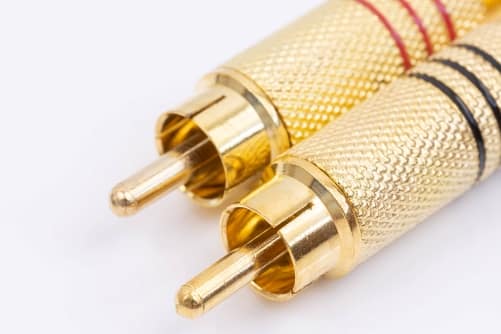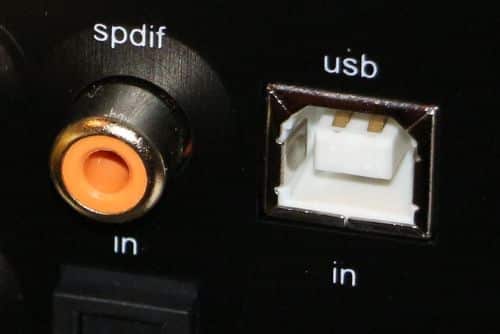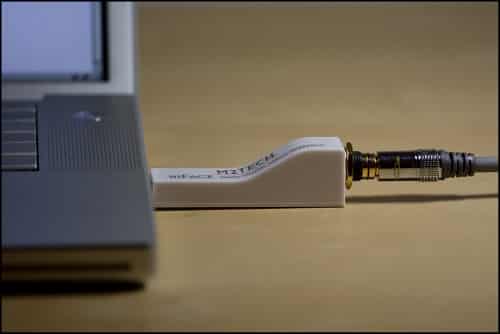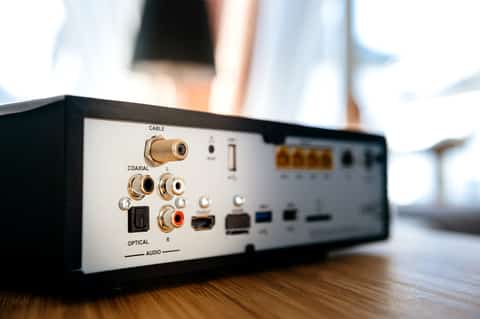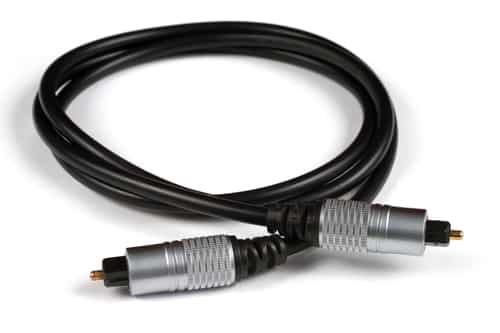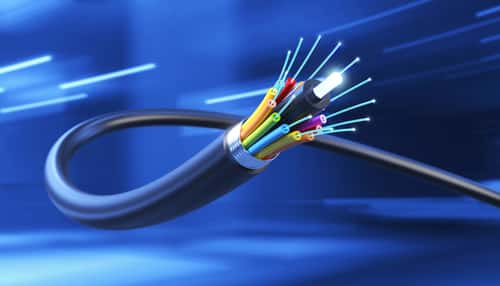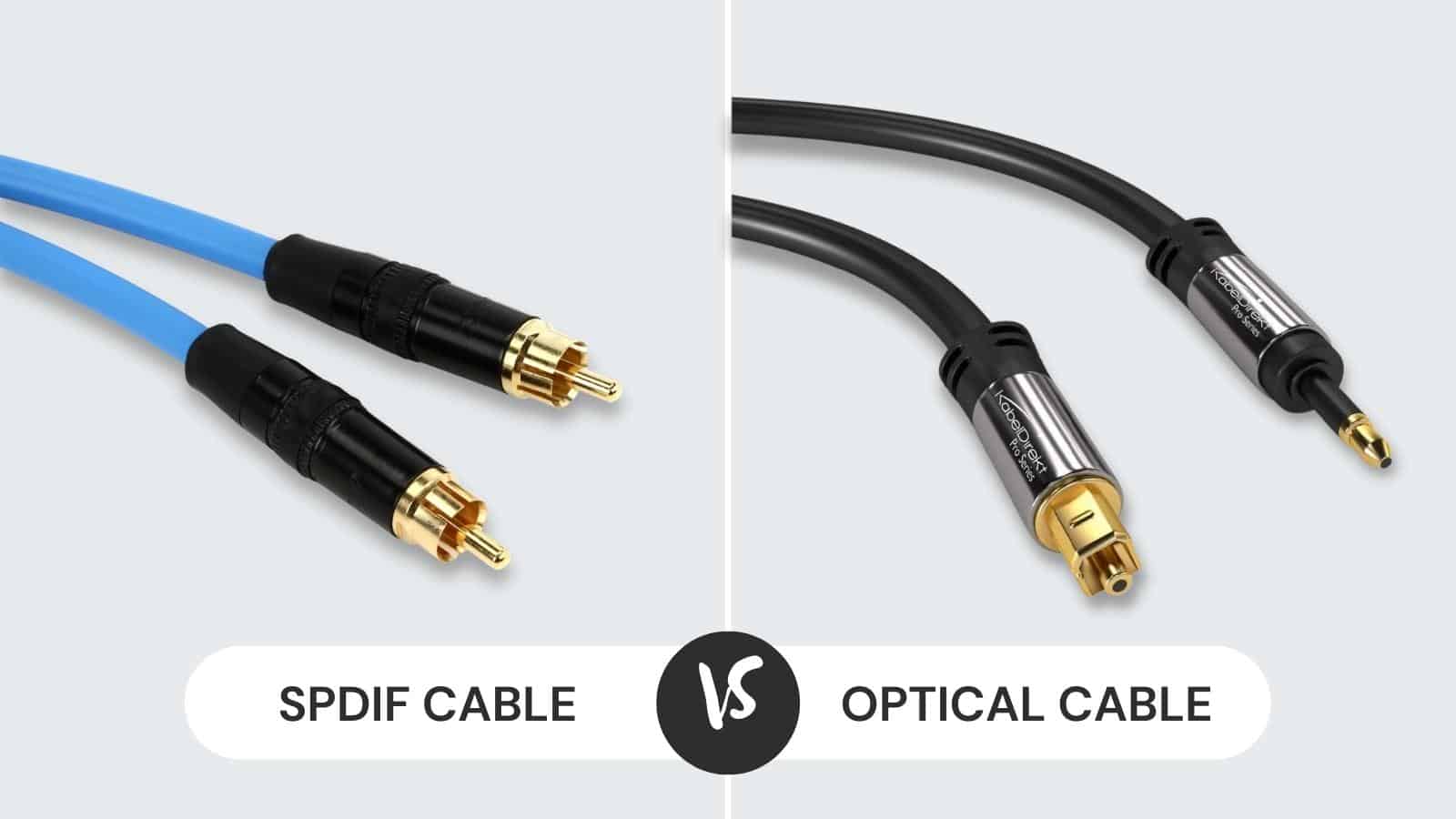
Using the right audio equipment is essential for making music, but which cables you are using can directly influence the power connections and audio quality. This is because the cables serve as a transmission medium.
SPDIF and optical cables are two commonly used cables for optimizing the audio data transmission. However, the beginners have a hard time selecting between these two but understanding their features can help make a sound decision.
SPDIF Vs. Optical Comparison
| SPDIF | Optical | |
|---|---|---|
| Signal quality | Not entirely noise-free | Clearer and consistent signals |
| Interference | Susceptible to interferences as it leverages electromagnetic current | Immune to electromagnetic and electrical interferences as they use light pulses |
| Length | More than 16ft – exact length depends on the type of cable and connectors | 16ft but extendable with connectors and boosters |
| Application | Connects DVD players with TVs and speakers | Connects Dolby decoders to sound equipment, consoles, and AV receivers |
| Appearance | Plastic/glass material connected with TOSLINK connectors | Coaxial SPDIF cables connected with RCA connectors |
SPDIF vs Optical Comparison
SPDIF Cable
SPDIF is the Sony/Philips Digital Interface, and it’s defined as an audio transfer interface. It allows the users to transfer the audio signals between two devices. SPDIF promises digital transfer of signals rather than converting the signals into analog form.
This is because the conventional form of signal conversion leads to degradation of the signal’s quality, leading to bad sound quality.
SPDIF is integrated with the RCA connectors on two ends and a coaxial cable to reduce the noise disruptions. In addition, the RCA connectors and a coaxial cable help protect the sound against interferences and maintain the signal quality as well as speed.
However, some SPDIF systems are designed with TOSLINK connectors and fiber optic cables for high-end music development, but these systems can be extremely expensive.
Irrespective of which SPDIF you use, the data loss will be minimal, and the data transfer speed will be enhanced. While it’s great to have SPDIF, it’s not compatible with every audio equipment, which is something you must check.
In particular, SPDIF only deals with digital signals and doesn’t convert to analog signals at all. For this reason, you must ensure that the audio equipment can work with only digital signals.
All in all, SPDIF is a great option if you want to optimize the quality and speed of audio signal transmission. This format was designed by Philips and Sony, and they standardized it in IEC 60958. This format was standardized as IEC 60958 Type II.
SPDIF can work with various cables, including optical and coaxial cables. This is because SPDIF works as the data link and encoding protocol rather than as cable or wire.
In particular, it’s a format that interconnects different components in home theatres and home entertainment systems with digital and high-fidelity systems for music and sound.
It is based on the AES3 standard and has two channels. These channels include compressed 5.1/7.1 sound and uncompressed PCM audio, including the DTS audio codec.
It cannot support the lossless surround formats, particularly if they use a higher bandwidth. SPDIF is one of the best ways of delivering high-end audio to the output components through an input component.
It’s safe to say that SPDIF is a cutting-edge audio connection as it can support high-end sound formats. SPDIF has a tough construction and comes in excellent lengths to achieve a longer lifespan and create a connection between different devices, respectively.
However, it’s not very flexible, and some users have complained about audio interference, but it cannot take away from its strong construction.
SPDIF format uses coaxial cables with an RCA connector that has a metal tip, which makes it a sturdy option. For the same reason, it’s used to connect the DVD players with speakers and televisions as it’s meant for entertainment.
Many people don’t use SPDIF since it consumes more electricity. However, the thick and stronger design of these cables allows them to reach more than 16ft distance, but longer distances often result in loss of audio signals.
Optical Cable
Optical cables are another medium for data transmission and ensuring the digital transmission of audio signals over the cables, promising a better user experience.
It’s important to add that optical cables are limited to 5.1 and stereo channels, which is why you must check the compatibility of your audio equipment.
As long as optical cables are compatible, there won’t be any delay, interference, or lags in the audio. The primary advantage of optical cable is that it’s compatible with nearly every audio device and is affordable.
It utilizes the ADAT and optical formats. The output signals that transmit through the cable must be converted or changed from the electrical signals to the light-based or optical signals.
Once the signal reaches the optical input or receiver, it goes through the conversion again – from optical signals to electric signals.
The optical cables were particularly designed to combat electromagnetic interference and radio frequency interference, as these interferences were common with coaxial cables.
The best thing about optical cables is that it doesn’t lose the audio signals over distances as the light doesn’t suffer from resistance or attenuation that’s found in the copper wires.
The optical cables are solely used for pairing up the audio devices and playing the devices, such as Blu-Ray and DVDs. It can connect these devices to media cards and receivers for optimizing sound and video.
t promises high-end results from every connection. The cables are pretty efficient and have become a reliable way of delivering high-end audio quality.
On the other hand, you need to be concerned about the sensitive construction and limited length.
Usually, the optical cables are made from plastic, silica, or glass, which makes the data transmission extremely efficient since there is no dependence on the electrical supply. The optical cable has a rugged appearance and is very thin.
Usually, these cables are connected with squared connectors, but it’s best to choose connectors that emit light. The optical cables can handle eight audio channels at 48 kHz or 44.1 simultaneously. In addition, it can support four channels at 96 kHz or 88.2.
It is important to add that these cables are very convenient to handle, but they are extremely fragile and prone to breakage.
It doesn’t allow any audio noise to pass to the DAC circuitry from the source. For this reason, it is suggested to use a socket while connecting the optical cable directly into the AV receiver or soundbar’s DAC.
Given this connectivity, the optical cable can be used with TVs, set-top boxes, and gaming consoles.
However, it doesn’t have sufficient bandwidth to support the lossless formats, including DTS-HD Master Audio tracks and Dolby TrueHD. Keep in mind that an optical cannot support more than two uncompressed audio channels.
This is because these cables are fragile and are prone to damage if bent too much.
Since it uses light pulses for transmitting data, it’s one of the most efficient options and is connected with the TOSLINK connectors to support an exceptional range of video and audio formats.
Last but not least, it can reach a 16ft distance, but repeaters, additional cables, and boosters can be connected to extend the length.
The Bottom Line
SPDIF is a promising choice for musicians who prefer digital signals for their quick transmission, while the optical cable is a suitable choice if you want wide-range compatibility and an affordable cabling solution.
As far as the sound quality and clarity are concerned, both of them do a great job, but SPDIF is prone to signal interference, which results in distortion.
Both these cables work pretty well, but it all comes down to the audio preferences. The optical cable carries eight channels, while SPDIF can support around two channels or can be connected to the stereo.
This is because SPDIF is the alternate communication protocol for ADAT that also utilizes optical and coaxial cables.

